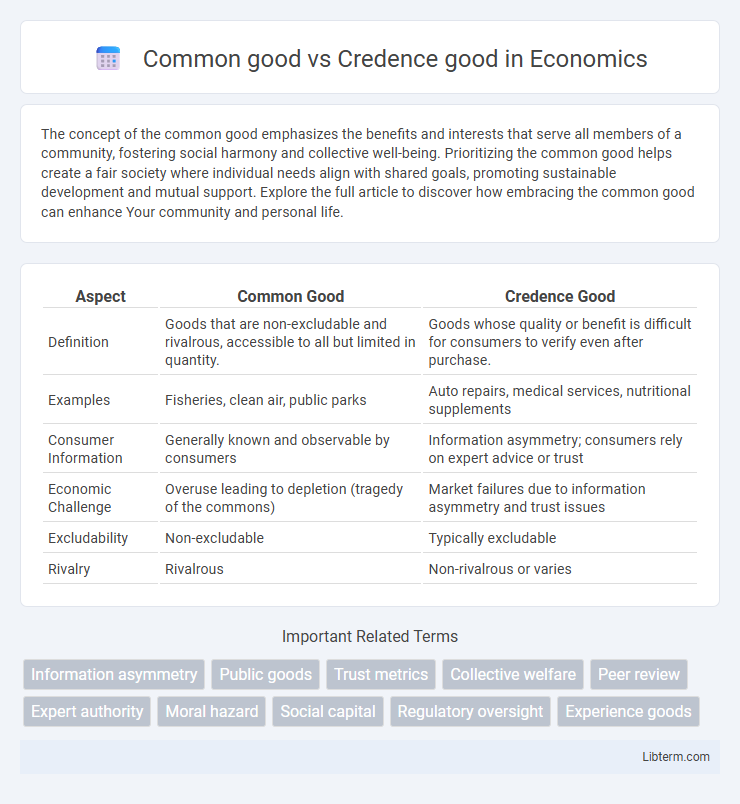The concept of the common good emphasizes the benefits and interests that serve all members of a community, fostering social harmony and collective well-being. Prioritizing the common good helps create a fair society where individual needs align with shared goals, promoting sustainable development and mutual support. Explore the full article to discover how embracing the common good can enhance Your community and personal life.
Table of Comparison
| Aspect | Common Good | Credence Good |
|---|---|---|
| Definition | Goods that are non-excludable and rivalrous, accessible to all but limited in quantity. | Goods whose quality or benefit is difficult for consumers to verify even after purchase. |
| Examples | Fisheries, clean air, public parks | Auto repairs, medical services, nutritional supplements |
| Consumer Information | Generally known and observable by consumers | Information asymmetry; consumers rely on expert advice or trust |
| Economic Challenge | Overuse leading to depletion (tragedy of the commons) | Market failures due to information asymmetry and trust issues |
| Excludability | Non-excludable | Typically excludable |
| Rivalry | Rivalrous | Non-rivalrous or varies |
Introduction to Common Goods and Credence Goods
Common goods are resources like fisheries or clean air that are non-excludable but rivalrous, meaning their consumption by one individual reduces availability for others. Credence goods, such as medical treatments or car repairs, have qualities that consumers find difficult to evaluate even after use, relying heavily on trust and expert knowledge. Understanding these distinctions is crucial for addressing challenges in resource management and consumer protection.
Defining Common Goods: Key Characteristics
Common goods are resources characterized by non-excludability and rivalry, meaning individuals cannot be effectively excluded from use, but consumption by one user reduces availability for others. Examples include fisheries, clean air, and public pastures, where overuse leads to depletion or degradation, known as the "tragedy of the commons." Managing common goods requires collective regulation or community management to sustain resource availability and prevent overexploitation.
Understanding Credence Goods: Main Features
Credence goods possess qualities that are difficult for consumers to evaluate even after purchase, relying heavily on trust in the provider's expertise and honesty. These goods often require specialized knowledge or information asymmetry, making it challenging for buyers to assess value or effectiveness independently. Examples include medical treatments, legal services, and car repairs, where consumers depend on expert evaluations to make informed decisions.
Real-world Examples of Common Goods
Common goods, such as clean air, public parks, and fisheries, are resources that are non-excludable yet rivalrous, meaning their consumption by one individual can reduce availability for others. Unlike credence goods, which require trust in the seller due to quality uncertainty--like medical treatments or car repairs--common goods face challenges like overuse and depletion, exemplified by overfishing in international waters. Effective management of common goods often depends on community regulation and government intervention to prevent the tragedy of the commons and ensure sustainable access.
Common Examples of Credence Goods
Credence goods are products or services whose qualities are difficult for consumers to evaluate even after consumption, such as medical treatments, legal advice, and car repairs. In contrast, common goods are resources like clean air, public parks, and fisheries, which are non-excludable and rivalrous in consumption. Consumers rely heavily on trust, expert reputation, and certifications when purchasing credence goods due to information asymmetry in these markets.
Differences Between Common Goods and Credence Goods
Common goods are non-excludable and rivalrous resources, such as fisheries or public parks, which can be depleted through overuse, whereas credence goods are products or services like medical treatments and legal advice, whose quality or necessity is difficult for consumers to assess even after consumption. The key difference lies in consumer knowledge and control: common goods face challenges of collective management and potential overconsumption, while credence goods present information asymmetry between provider and consumer, leading to potential exploitation or trust issues. Management of common goods centers on sustainable use and access, whereas credence goods require mechanisms for quality assurance and transparency to protect consumer interests.
The Role of Trust and Information in Credence Goods
Credence goods, such as medical treatments or legal services, rely heavily on trust due to the consumer's inability to fully assess the product's quality even after consumption, unlike common goods which are easily evaluated. Information asymmetry between providers and consumers makes trust a critical factor in purchase decisions, as consumers depend on expert knowledge and honesty to determine value. Effective mechanisms like certifications, warranties, and transparent communication reduce uncertainty and enhance confidence in credence goods markets.
Challenges in Managing Common Goods
Managing common goods presents challenges such as the "tragedy of the commons," where individual users overconsume or deplete shared resources like fisheries or clean air due to lack of exclusive ownership. Monitoring and enforcing sustainable usage is difficult because common goods are non-excludable and rivalrous, creating incentives for free-riding and overexploitation. Effective governance mechanisms, including community management or government intervention, are essential to balance access and preservation while addressing collective action problems.
Policy Implications: Regulating Both Good Types
Regulating common goods involves preventing overuse and depletion through measures like quotas, permits, or community management to sustain shared resources such as fisheries and clean air. Credence goods require policies enhancing transparency and trust, including mandatory information disclosure, certification, and quality inspections, to protect consumers from asymmetrical information in markets like healthcare and specialty foods. Effective regulation of both good types demands tailored approaches that address their unique economic characteristics to promote sustainability and consumer welfare.
Conclusion: Balancing Public Benefit and Consumer Protection
Balancing the public benefit of common goods, such as clean air and public parks, with the consumer protection needed for credence goods, like medical treatments or organic foods, requires tailored regulatory approaches that ensure accessibility and trust. Effective policies must address the non-excludable and non-rivalrous nature of common goods while mitigating information asymmetry and potential fraud inherent to credence goods. Achieving this balance fosters sustainable resource use and informed consumer choices, promoting overall social welfare.
Common good Infographic

 libterm.com
libterm.com